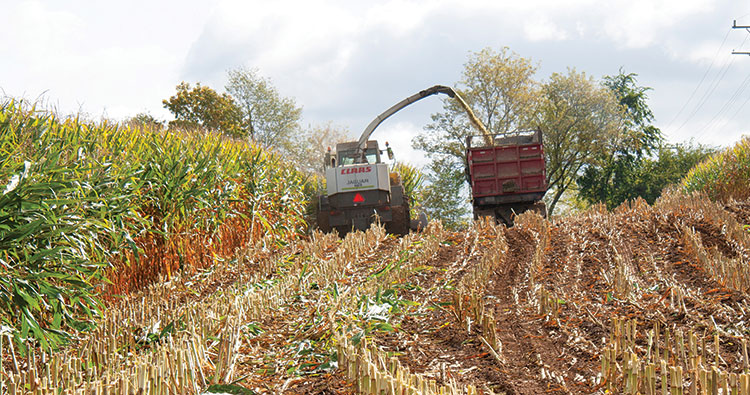
For nearly every dairy farmer, corn silage harvest season is one of the most important periods of the entire year. As more and more farms transition toward rations high in corn silage, it becomes even more critical.
The short window available for harvesting sets the stage for the entire feeding year. That’s why Wisconsin dairyman Brody Stapel of Double Dutch Dairy shared that his corn silage strategy begins as the previous crop is put into storage.
“Growing corn silage is a yearlong process,” he explained during a Professional Dairy Producers of Wisconsin (PDPW) Dairy Signal webcast. “It actually starts in September when you’re chopping. That’s because you want to know how that certain hybrid did.”
Stapel evaluates his corn as it’s harvested and stored to help determine seed selection for the next year. He considers plant health a cornerstone of this process. Building on that, the dairy opts for soft kernel, highly digestible corn hybrids that provide the Cedar Grove, Wis., dairy with a wider harvest window. Some years, they need corn to stay green for two to three weeks for harvest.
At Clover Hill Dairy in Campbellsport, Wis., Brett Bonlender also prioritizes a soft kernel. Additionally, his operation selects for non-GMO, flex-ear hybrids that are planted at a low population.
When it comes to hybrid selection at Mystic Valley Dairy in Sauk City, Wis., Mitch Breunig looks for high yield, high digestibility, high starch, and a hybrid that performs well across various soil types and weather.
“Our corn seed supplier brings really good service to us and helps us get it planted, growing, and ready to harvest,” Breunig said of his strategy for achieving consistent and high-quality silages. “My nutritionist has to feed it so it’s really good to have those two people talking to each other. We also have an agronomist that helps us grow the crop after it’s planted. We put all three of those people in a room together.”
There’s more to good silage
These early decisions set the stage for the growing season. “Getting it harvested, getting the timing of everything, it’s really hard,” admitted Breunig. That’s one reason his operation gets corn silage hybrids planted first followed by high moisture corn and grain corn hybrids. If they aren’t able to get enough of the silage hybrids harvested to fill their needs for the year, they utilize some of the high moisture corn acres for silage as well. He shared that this strategy allows them to get adequate amounts of corn for silage even if they have a bad weather year.
At Bonlender’s Clover Hill Dairy, a cold germination of the corn is completed before the seed even goes in the ground. “Every lot number of every corn I buy goes into the lab and gets tested,” Bonlender shared. “We go through all this work to do everything right and try to minimize all the risk. If you don’t know what your corn is testing, you could be 20% not germinated and not know it. That’s one thing we can control.”
Once he gets those seeds in the ground, he sets goals for the field. His farm shoots for greater than 30 tons per acre and 35% to 40% starch. They want the corn green to the ground, nearly at black layer stage, and highly digestible at harvest.
“Then, you have one chance that’s a week-long to get that product in the bunker, stored, and packed,” Stapel said of the importance of the harvest. “It’s feed for the rest of the year for your herd and possibly your heifers.”
Within the harvesting window, Stapel has focused increasing attention on the storage plan for their forages. They moved from storing feeds in upright silos to a 90- by 200-foot blacktop pad. They also narrowed their silage face so that they could feed out more of the face each day to their 250 head of milking cows.
At Breunig’s Mystic Valley Dairy, they store forages in bunkers that are covered in an oxygen barrier and plastic. They also wrap the bunker walls before adding forage to further reduce spoilage opportunities for the farm’s 400 cows.
Balancing forages
Breunig and Stapel aim to prioritize corn silage in their diets with their forages averaging two-thirds corn silage and one-third haylage. They both credit the affordability and nutrition of corn silage with carrying their rations and helping bolster their farm’s strong milk productions.
Part of that is because alfalfa has been difficult to grow the last few years, but they still mix their corn silage with either alfalfa or mixed grasses.
“Really good corn silage is such a beautiful match for high-quality alfalfa. You can use both of those products together really well,” Breunig detailed.
For Bonlender, the forage balance between corn silage and alfalfa runs closer to a one-to-one ratio. “We are not as heavy in corn silage because our animals don’t respond as well to the high-starch, heavy corn silage diets as others,” he explained. His 2,150 cows are all three-way crossbred with Montbéliarde, Viking Red, and European Frisian.
“We started as a high corn silage diet and realized that they just did not perform well on it. Their breed by nature is a grazer,” he explained. “They love forages. That’s why we started going with a more one-to-one ratio.”
As farmers review their corn silage plan, Bonlender has this thought to leave them with. “One thing I have learned is to not do something just because it’s easy. Listen to your crops, ground, and animals. Take that extra step and try to do what’s right,” he said.










